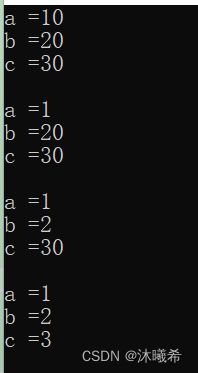【C++初阶】C++入门(一)
大家好我是沐曦希
文章目录
- 1.前言
- 2.C++关键字(C++98)
- 3.命名空间namespace
-
- 3.1 命名空间定义
- 3.2 命名空间使用
-
- 3.2.1 加命名空间名称及作用域限定符
- 3.2.2 使用using将命名空间中某个成员引入
- 3.2.3 使用using namespace 命名空间名称 引入
- 4.C++输入&输出
-
- 4.1 命名空间完全展开
- 4.2 命名空间的指定
- 4.3 命名空间的部分展开
- 5.缺省参数
-
- 5.1 缺省参数概念
- 5.2 缺省参数分类
-
- 5.2.1 全缺省参数
- 5.2.2 半缺省参数
- 缺省参数应用场景
- 6.写在最后
1.前言
C++是在C的基础之上,容纳进去了面向对象编程思想,并增加了许多有用的库,以及编程范式等。熟悉C语言之后,对C++学习有一定的帮助,C++入门主要目标:
- 补充C语言语法的不足,以及C++是如何对C语言设计不合理的地方进行优化的,比如:作用域方面、IO方面、函数方面、指针方面、宏方面等。
- 为后续类和对象学习打基础
2.C++关键字(C++98)
C++总计63个关键字,C语言32个关键字
| asm | do | if | return | try | continue |
|---|---|---|---|---|---|
| auto | double | inline | short | typedef | for |
| bool | dynamic_cast | int | signed | typeid | public |
| break | else | long | sizeof | typename | throw |
| case | enum | mutable | static | union | wchar_t |
| catch | explicit | namespace | static_cast | unsigned | default |
| char | export | new | struct | using | friend |
| class | extern | operator | switch | virtual | register |
| const | false | private | template | void | true |
| const_cast | float | protected | this | volatile | while |
| delete | goto | reinterpret_cast |
3.命名空间namespace
在C/C++中,变量、函数和后面要学到的类都是大量存在的,这些变量、函数和类的名称将都存在于全局作用域中,可能会导致很多冲突。使用命名空间的目的是对标识符的名称进行本地化,以避免命名冲突或名字污染,namespace关键字的出现就是针对这种问题的。
#include编译后后报错:error C2365: “rand”: 重定义;以前的定义是“函数”
#include3.1 命名空间定义
定义命名空间,需要使用到namespace关键字,后面跟命名空间的名字,然后接一对{}即可,{}中即为命名空间的成员。
#include注意:一个命名空间就定义了一个新的作用域,命名空间中的所有内容都局限于该命名空间中。
需要注意的是:只有同一级的相同名称的命名空间在编译运行时候,才会被合并。不同命名空间/域中可以定义同一个变量。同一个命名空间不能定义同一个变量。
放在命名空间的变量,不会影响该变量的生命周期,只是限定域,影响了编译器的查找规则(先找局部,后找全局),编译器在编译和运行时候不会查找在命名空间的定义的变量和函数,相当于增加了一堵墙。
namespace N1
{
int rand = 10;//全局变量(放在静态区)
}
namespace N2
{
int rand = 20;//全局变量
}
3.2 命名空间使用
那么命名空间如何使用呢?
namespace bit
{
// 命名空间中可以定义变量/函数/类型
int a = 0;
int b = 1;
int Add(int left, int right)
{
return left + right;
}
struct Node
{
struct Node* next;
int val;
};
}
int main()
{
// 编译报错:error C2065: “a”: 未声明的标识符
printf("%d\n", a);
return 0;
}
命名空间的使用有三种方式:
3.2.1 加命名空间名称及作用域限定符
int main()
{
printf("%d\n", N::a);
return 0;
}
3.2.2 使用using将命名空间中某个成员引入
using bit::b;
int main()
{
printf("%d\n", bit::a);
printf("%d\n", b);
return 0;
}
3.2.3 使用using namespace 命名空间名称 引入
using namespace bit;
int main()
{
printf("%d\n", a);
printf("%d\n", b);
return 0;
}
4.C++输入&输出
4.1 命名空间完全展开
#include说明:
- 使用cout标准输出对象(控制台)和cin标准输入对象(键盘)时,必须包含< iostream >头文件以及按命名空间使用方法使用std。
- cout和cin是全局的流对象,endl是特殊的C++符号,表示换行输出,他们都包含在包含头文件中。
- <<是流插入运算符,>>是流提取运算符。
- 使用C++输入输出更方便,不需要像printf/scanf输入输出时那样,需要手动控制格式。C++的输入输出可以自动识别变量类型。
- 实际上cout和cin分别是ostream和istream类型的对象,>>和<<也涉及运算符重载等知识,这些知识后续会学习,这里只是简单讲解他们的使用。
C++自动识别变量的类型本质是:函数重载
注意:早期标准库将所有功能在全局域中实现,声明在.h后缀的头文件中,使用时只需包含对应头文件即可,后来将其实现在std命名空间下,为了和C头文件区分,也为了正确使用命名空间,规定C++头文件不带.h;旧编译器(vc 6.0)中还支持
格式,后续编译器已不支持,因此推荐使用+std的方式。
4.2 命名空间的指定
#include::域作用的限定符
取到全局变量的值:
#include4.3 命名空间的部分展开
#include#include std命名空间的使用惯例:
std是C++标准库的命名空间,如何展开std使用更合理呢?
- 在日常练习中,建议直接using namespace std即可,这样就很方便。
- using namespace std展开,标准库就全部暴露出来了,如果我们定义跟库重名的类型/对象/函数,就存在冲突问题。该问题在日常练习中很少出现,但是项目开发中代码较多、规模大,就很容易出现。所以建议在项目开发中使用,像std::cout这样使用时指定命名空间 +using std::cout展开常用的库对象/类型等方式。
5.缺省参数
5.1 缺省参数概念
缺省参数是声明或定义函数时为函数的参数指定一个缺省值。在调用该函数时,如果没有指定实参则采用该形参的缺省值,否则使用指定的实参。
#include
缺省需要注意的是:只能从右往左连续缺省。缺省必须是局部变量和全局变量,缺省参数不能在函数声明和定义中同时出现,只能在声明中即.h头文件中定义缺省参数。
5.2 缺省参数分类
5.2.1 全缺省参数
#includeFunc(1, ,3);//错误的
5.2.2 半缺省参数
void Func(int a, int b = 10, int c = 20)
{
cout<<"a = "<<a<<endl;
cout<<"b = "<<b<<endl;
cout<<"c = "<<c<<endl;
}
注意:
- 半缺省参数必须从右往左依次来给出,不能间隔着给。
- 缺省参数不能在函数声明和定义中同时出现。
//a.h
void Func(int a = 10);
// a.cpp
void Func(int a = 20)
{}
// 注意:如果生命与定义位置同时出现,恰巧两个位置提供的值不同,那编译器就无法确定到底该用那个缺省值。
- 缺省值必须是常量或者全局变量
- C语言不支持(编译器不支持)
缺省参数应用场景
在进行数据结构的链表等可以更加高效。
#include6.写在最后
那么C++入门上就到这里结束了。






